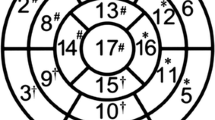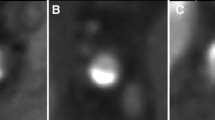Abstract
Purpose
Our aim was to evaluate the diagnostic accuracy of 64-slice computed tomography coronary angiography (MSCT-CA) for detecting significant stenosis (≥50% lumen reduction) in a population of patients at low to intermediate risk.
Materials and methods
We studied 72 patients (38 men, 34 women, mean age 53.9±8.0 years) with atypical or typical chest pain and stratified in the low-to intermediate risk category. MSCT-CA (Sensation 64 Cardiac, Siemens, Germany) was performed after IV administration of 100 ml of iodinated contrast material (Iomeprol 400 mgI/ml, Bracco, Italy). Two observers, blinded to the results of conventional coronary angiography (CAG), assessed the MSCT-CA scans in consensus. Diagnostic accuracy for detecting significant stenosis was calculated.
Results
CAG demonstrated the absence of significant disease in 70.1% of patients (51/72). No patient was excluded from MSCT-CA. There were 37 significant lesions on 1,098 available coronary segments. Sensitivity, specificity and positive and negative predictive value of MSCT-CA for detecting significant coronary artery on a per-segment basis were 100%, 98.6%, 71.2% and 100%, respectively. All patients with at least one significant lesion were correctly identified by MSCT-CA. MSCT-CA scored 15 false positives on a per-segment base, which affected only marginally the per-p.atient performance (only one false positive).
Conclusions
We concluded that 64-slice CT-CA is a diagnostic modality with high sensitivity and negative predictive value in patients at low to intermediate risk.
Riassunto
Obiettivo
Valutare l’accuratezza diagnostica dell’angiografia coronarica non invasiva con tomografia computerizzata (AC-TC) a 64 strati nell’individuazione delle stenosi coronariche significative (riduzione del lume coronarico ≥ 50%) in una popolazione di pazienti a basso-intermedio rischio cardiovascolare.
Materiali e metodi
Sono stati studiati 72 pazienti (38 maschi, 34 donne, età media 53,9±8,0 anni) che presentavano dolore toracico atipico o angina pectoris stabile e che venivano stratificati nella categoria del rischio basso-intermedio. Per la scansione AC-TC sono stati iniettati endovena 100 ml di mezzo di contrasto (Iomeprolo 400 mgI/ml, Bracco, Italia). Due osservatori, in cieco rispetto alla coronarografia convenzionale CAG), hanno valutato in consenso le immagini dell’AC-TC. Sono stati quindi calcolati i valori di accuratezza diagnostica per la rilevazione di stenosi significative.
Risultati
L’angiografia coronarica invasiva ha dimostrato l’assenza di malattia o la presenza di malattia non critica nel 70,1% dei pazienti (51/72). Nessun paziente è stato escluso dalla popolazione studiata. Sono state individuate 37 lesioni significative su 1098 segmenti disponibili. Sensibilità, specificità, valore predittivo positivo e negativo dell’AC-TC nella determinazione delle stenosi significative utilizzando un’analisi per segmenti sono risultate, rispettivamente, del 100%, 98,6%, 71,2% e 100%. Tutti i pazienti con almeno una lesione significativa sono stati correttamente identificati anche nella valutazione con AC-TC. L’AC-TC ha generato 15 falsi postivi su base segmentale che però si riducono a un solo falso positivo nell’analisi per paziente.
Conclusioni
L’AC-TC a 64 strati rappresenta una metodica diagnostica ad elevata sensibilità e valore predittivo negativo nei pazienti con rischio basso o intermedio.
Similar content being viewed by others
References/Bibliografia
Cademartiri F, Luccichenti G, Marano R et al (2003) Non-invasive angiography of the coronary arteries with multislice computed tomography: state of the art and future prospects. Radiol Med (Torino) 106:284–296
Cademartiri F, Luccichenti G, Marano R et al (2003) Spiral CT-angiography with one, four, and sixteen slice scanners. Technical note. Radiol Med (Torino) 106:269–283
Mollet NR, Cademartiri F, Nieman K et al (2004) Multislice spiral computed tomography coronary angiography in patients with stable angina pectoris. J Am Coll Cardiol 43:2265–2270
Cademartiri F, Malagutti P, Belgrano M et al (2005) Non-invasive coronary angiography with 64-slice computed tomography. Minerva Cardioangiol 53:465–472
Cademartiri F, Runza G, Belgrano M et al (2005) Introduction to coronary imaging with 64-slice computed tomography. Radiol Med (Torino) 110:16–41
Mollet NR, Cademartiri F, Krestin GP et al (2005) Improved diagnostic accuracy with 16-row multi-slice computed tomography coronary angiography. J Am Coll Cardiol 45:128–132
Mollet NR, Cademartiri F, van Mieghem CA et al (2005) High-resolution spiral computed tomography coronary angiography in patients referred for diagnostic conventional coronary angiography. Circulation 112:2318–2323
Nieman K, Oudkerk M, Rensig BJ et al (2001) Coronary angiography with multislice computed tomography. Lancet 357:599–603
Nieman K, Cademartiri F, Lemos PA et al (2002) Reliable noninvasive coronary angiography with fast submillimeter multislice spiral computed tomography. Circulation 106:2051–2054
Nieman K, Rensing BJ, van Geuns RJ et al (2002) Usefulness of multislice computed tomography for detecting obstructive coronary artery disease. Am J Cardiol 89:913–918
Ropers D, Baum U, Pohle K et al (2003) Detection of coronary artery stenoses with thin-slice multi-detector row spiral computed tomography and multiplanar reconstruction. Circulation 107:664–666
Achenbach S, Ropers D, Pohle FK et al (2005) Detection of coronary artery stenoses using multi-detector CT with 16 × 0.75 collimation and 375 ms rotation. Eur Heart J 26:1978–1986
Raff GL, Gallagher MJ, O’Neill WW, Goldstein JA (2005) Diagnostic accuracy of noninvasive coronary angiography using 64-slice spiral computed tomography. J Am Coll Cardiol 46:552–557
Leschka S, Alkadhi H, Plass A et al (2005) Accuracy of MSCT coronary angiography with 64-slice technology: first experience. Eur Heart J 26:1482–1487
Schuijf JD, Pundziute G, Jukema JW et al (2006) Diagnostic accuracy of 64-slice multislice computed tomography in the noninvasive evaluation of significant coronary artery disease. Am J Cardiol 98:145–148
Garcia MJ, Lessick J, Hoffmann MH (2006) Accuracy of 16-row multidetector computed tomography for the assessment of coronary artery stenosis. Jama 296:403–411
Ropers D, Rixe J, Anders K et al (2006) Usefulness of multidetector row spiral computed tomography with 64-x 0.6-mm collimation and 330-ms rotation for the noninvasive detection of significant coronary artery stenoses. Am J Cardiol 97:343–348
Fox K, Garcia MA, Ardissino D et al (2006) Guidelines on the management of stable angina pectoris: executive summary: the Task Force on the Management of Stable Angina Pectoris of the European Society of Cardiology. Eur Heart J 27:1341–1381
Nikolaou K, Rist C, Wintersperger BJ et al (2006) Clinical value of MDCT in the diagnosis of coronary artery disease in patients with a low pretest likelihood of significant disease. AJR Am J Roentgenol 186:1659–1668
Cademartiri F, Nieman K, van der Lugt A et al (2004) Intravenous contrast material administration at 16-detector row helical CT coronary angiography: test bolus versus bolus-tracking technique. Radiology 233:817–823
Austen WG, Edwards JE, Frye RL et al (1975) A reporting system on patients evaluated for coronary artery disease. Report of the Ad Hoc Committee for Grading of Coronary Artery Disease, Council on Cardiovascular Surgery, American Heart Association. Circulation 51:5–40
Hendel RC, Patel MR, Kramer CM et al (2006) ACCF/ACR/SCCT/SCMR/ASNC/NAS CI/SCAI/SIR 2006 appropriateness criteria for cardiac computed tomography and cardiac magnetic resonance imaging: a report of the American College of Cardiology Foundation Quality Strategic Directions Committee Appropriateness Criteria Working Group, American College of Radiology, Society of Cardiovascular Computed Tomography, Society for Cardiovascular Magnetic Resonance, American Society of Nuclear Cardiology, North American Society for Cardiac Imaging, Society for Cardiovascular Angiography and Interventions, and Society of Interventional Radiology. J Am Coll Cardiol 48:1475–1497
Juergens KU, Grude M, Fallenberg EM et al (2002) Using ECG-gated multidetector CT to evaluate global left ventricular myocardial function in patients with coronary artery disease. AJR Am J Roentgenol 179:1545–1550
Juergens KU, Grude M, Maintz D et al (2004) Multi-detector row CT of left ventricular function with dedicated analysis software versus MR imaging: initial experience. Radiology 230:403–410
Schuijf JD, Bax JJ, Jukema JW et al (2004) Noninvasive angiography and assessment of left ventricular function using multislice computed tomography in patients with type 2 diabetes. Diabetes Care 27:2905–2910
Heuschmid M, Rothfuss JK, Schroeder S et al (2005) Assessment of left ventricular myocardial function using 16-slice multidetector-row computed tomography: comparison with magnetic resonance imaging and echocardiography. Eur Radiol 16:551–559
Salm LP, Schuijf JD, de Roos A et al (2006) Global and regional left ventricular function assessment with 16-detector row CT: Comparison with echocardiography and cardiovascular magnetic resonance. Eur J Echocardiogr 7:308–314
Schuijf JD, Bax JJ, Salm LP et al (2005) Noninvasive coronary imaging and assessment of left ventricular function using 16-slice computed tomography. Am J Cardiol 95:571–574
Henneman MM, Bax JJ, Schuijf JD et al (2006) Global and regional left ventricular function: a comparison between gated SPECT, 2D echocardiography and multi-slice computed tomography. Eur J Nucl Med Mol Imaging 33:1452–1460
Gibbons RJ, Balady GJ, Bricker JT et al (2002) ACC/AHA 2002 guideline update for exercise testing: summary article. A report of the American College of Cardiology/American Heart Association Task Force on Practice Guidelines (Committee to Update the 1997 Exercise Testing Guidelines). J Am Coll Cardiol 40:1531–1540
Lauer M, Froelicher ES, Williams M, Kligfield P (2005) Exercise testing in asymptomatic adults: a statement for professionals from the American Heart Association Council on Clinical Cardiology, Subcommittee on Exercise, Cardiac Rehabilitation, and Prevention. Circulation 112:771–776
Christopher Jones R, Pothier CE, Blackstone EH, Lauer MS (2004) Prognostic importance of presenting symptoms in patients undergoing exercise testing for evaluation of known or suspected coronary disease. Am J Med 117:380–389
Jakobs TF, Becker CR, Ohnesorge B et al (2002) Multislice helical CT of the heart with retrospective ECG gating: reduction of radiation exposure by ECG-controlled tube current modulation. Eur Radiol 12:1081–1086
Flohr TG, McCollough CH, Bruder H et al (2006) First performance evaluation of a dual-source CT (DSCT) system. Eur Radiol 16:256–268
Johnson TR, Nikolaou K, Wintersperger BJ et al (2006) Dual-source CT cardiac imaging: initial experience. Eur Radiol 16:1409–1415
Scheffel H, Alkadhi H, Plass A et al (2006) Accuracy of dual-source CT coronary angiography: first experience in a high pre-test probability population without heart rate control. Eur Radiol 16:2739–2747
Author information
Authors and Affiliations
Corresponding author
Rights and permissions
About this article
Cite this article
Cademartiri, F., Maffei, E., Palumbo, A. et al. Diagnostic accuracy of 64-slice computed tomography coronary angiography in patients with low-to-intermediate risk. Radiol med 112, 969–981 (2007). https://doi.org/10.1007/s11547-007-0198-5
Received:
Accepted:
Published:
Issue Date:
DOI: https://doi.org/10.1007/s11547-007-0198-5
Key words
- Multislice computed tomography
- CT coronary angiography
- Conventional coronary angiography
- Coronary artery disease
- 64-slice CT
- Low cardiovascular risk




